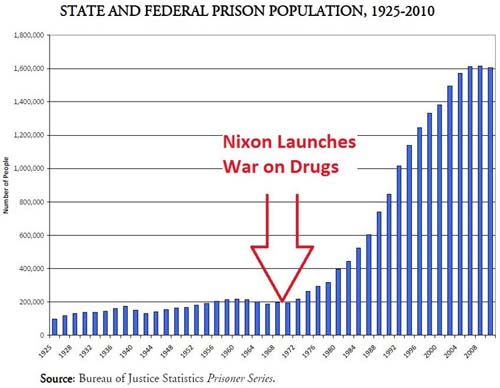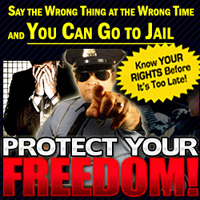Sean Kerrigan, Contributor
Activist Post
In the early 1970s, the prison population in the United States was small and was steadily falling relative to the size of the population. Experts imagined that in a few decades, the prison system as we know it could be successfully dismantled, but that began to change after President Nixon began the War on Drugs in 1971, resulting in a huge influx of convicts.
 |
| CLICK IMAGE TO ENLARGE |
The massive increase in prisoners has given rise to what some call the Prison Industrial Complex. Like its cousin, the Military Industrial Complex, government policy and spending continues to make private involvement in the prison system very lucrative. Taxpayer money is transferred to corporations to satisfy the increasing number of prisoners as a result of the drug war.
As these corporations become bigger and more powerful, they can lobby for policies that will increase their business. Their business is to see you behind bars. More prisoners means more profit, which means more influence. It’s a continuing cycle that has reached a tipping point.
Like all big businesses, private prisons invest heavily in government lobbying to ensure an ever increasing supply of new customers, in this case prisoners. Currently, private prison companies are negotiating with states to buy and manage public prisons, if in exchange the state can promise occupancy rates remain above 90 percent for at least 20 years. This of course only adds to incentivize the states to prosecute more citizens for more crimes.
The Corrections Corporation of America’s annual filing even admits this is their goal:
The demand for our facilities and services could be adversely affected by the relaxation of enforcement efforts, leniency in conviction or parole standards and sentencing practices or through the decriminalization of certain activities that are currently proscribed by our criminal laws…For instance, any changes with respect to drugs and controlled substances or illegal immigration could affect the number of persons arrested, convicted, and sentenced, thereby potentially reducing demand for correctional facilities to house them.
In some cases, the private prison industry has even assisted in writing the laws designed to increase the prison population, as was the case with the controversial Arizona law SB 1070, which would inevitably jail foreign nationals suspected of being in the country illegally.
The US has 25 percent of the world’s prisoners. It’s incarceration rate is the highest in the world and has increased by 10 percent since 2000. The US incarceration rate is only slightly lower than in the Soviet Union at the height of the gulag system just before World War II. At current rates, the US will surpass the gulag system by 2018!
Financial writer Jeff Neilson has recently noted that while US new home inventory has been “plummeting straight down,” other reports indicate that construction of homes are up significantly, producing “50 to 100 percent more units than they sell.” Neilson’s conclusion?
Either the official U.S. housing numbers were total fabrications; or, more than half of these ‘housing starts’ were units which did not require a ‘sale’ to an individual owner in order for the builder to be paid (since no builder can stay in business building twice as many units as they sell).
In attempting to come up with an answer to the question ‘how could millions of new U.S. housing units not require sale to an owner?,’ I could only formulate one possibility. All of these phantom housing starts were in fact prison cells.
Slave Labor
 The 13th Amendment to the Constitution specifically outlaws slavery “except as a punishment for crime,” meaning that convicted prisoners can be used as a source of forced servitude. During times of economic stress, demand for cheap prison labor increases.
The 13th Amendment to the Constitution specifically outlaws slavery “except as a punishment for crime,” meaning that convicted prisoners can be used as a source of forced servitude. During times of economic stress, demand for cheap prison labor increases.
With the expansion of the private prison system, we’re seeing new interest in the practice that goes way beyond making license plates.
While cheap sweatshop labor is becoming increasingly common across the country, no one takes better advantage of the system than prisons.
Alternet reports that almost 1 million prisoners are doing simple unskilled labor including “making office furniture, working in call centers, fabricating body armor, taking hotel reservations, working in slaughterhouses, or manufacturing textiles, shoes, and clothing, while getting paid somewhere between 93 cents and $4.73 per day.” They continue:
Rarely can you find workers so pliable, easy to control, stripped of political rights, and subject to martial discipline at the first sign of recalcitrance — unless, that is, you traveled back to the nineteenth century when convict labor was commonplace nationwide…It was one vital way the United States became a modern industrial capitalist economy — at a moment, eerily like our own, when the mechanisms of capital accumulation were in crisis.
Compare the cost of less than $5 a day with the cost of a minimum wage worker at $58 a day and you begin to see the perverse influence on the entire labor market.
CNN Money reports that prison inmates are now directly competing for jobs in the rest of the economy, and employers are finding it increasingly difficult to keep up. Lost jobs are the result. They cite one company, American Apparel Inc., which makes military uniforms. They write:
‘We pay employees $9 on average,’ [a company executive] said. ‘They get full medical insurance, 401(k) plans and paid vacation. Yet we’re competing against a federal program that doesn’t pay any of that.’
[The private prison] is not required to pay its workers minimum wage and instead pays inmates 23 cents to $1.15 an hour. It doesn’t have health insurance costs. It also doesn’t shell out federal, state or local taxes.
The new influx of cheap, domestic labor will inevitably drive down wages for both skilled and unskilled jobs.
Perverse Incentives
The profitability of privately run prison system has led to an increase in abuse within government positions. In 2009, two judges were convicted of fraud for accepting kickbacks from private prisons for sending juveniles to prison, even for minor offenses. In one instance, a 17-year-old student was sentenced to three months in prison for creating a fake MySpace page mocking an assistant principal.
The expansion of the American-style gulag will require the subversion of the jury trial (and jury nullification) or replaced all together with a system that provides fewer checks to protect the innocent. Misdemeanors will be reclassified as felonious. Decriminalization efforts that have succeeded will be reversed. People will be imprisoned for offenses not even considered crimes, or held without trial.
The financial justification for private prisons is in question as well. The New York Times, The Arizona Republic, and the Associated Press, have noted that governments save little if any money by privatizing the prison system. The Times notes that statistics are often manipulated since private prisons are more than willing to take healthy inmates, but tend to reject inmates with expensive health conditions, making the operation appear more cost effective than it is.
RELATED ACTIVIST POST ARTICLE:
World’s Prison Capital is Also #1 in For-Profit Prisons
Related Article:
They Tell Us “See Something, Say Something.” Well, I See Something
The Department of Homeland Security regularly warns us to…
Sean Kerrigan is a freelance journalist and occasional blogger concentrating on new media, finance, and politics. He has written for several daily and weekly newspapers including the Bucks County Courier Times. He is also the author of Corporatocracy: An Introduction to the New American Government.
linkwithin_text=’Related Articles:’


Be the first to comment on "The Prison System Expands at Frightening Pace Following Declaration of War on Drugs"